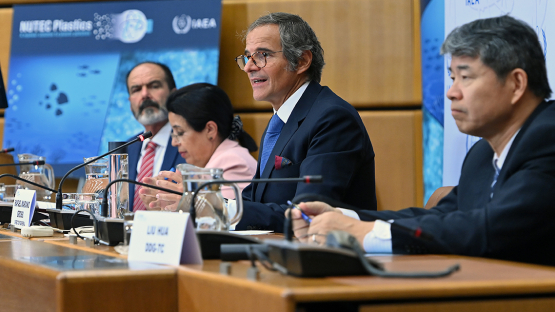Plastic pollution is an issue that transcends national boundaries, as one of today’s most pressing global environmental challenges directly threatening sustainable development. Around the world, one million plastic drinking bottles are purchased every minute, and 5 trillion single-use plastic bags are thrown away each year. Approximately 70 per cent of all plastics produced to date is now waste and only 9 per cent of this has been recycled. Projections indicate that by 2025 the ocean will contain one tonne of plastic for every three tonnes of fish, and by 2050, there may be more plastic in the ocean than fish, by volume.
“We are all, as a human society, affected by this problem of plastic pollution. This issue is now reaching alarming levels, and this means, within the international community and the involved actors, we need to tackle this in a different way – we need a proportionate response to the issue,” said IAEA Director General Rafael Mariano Grossi, during a virtual roundtable yesterday with ministers, heads of institutions, high-level decision makers and partners in North, Central and South America and the Caribbean. The meeting focused on identifying innovative solutions and partnerships to confront plastic pollution. “The IAEA aims to rise to the challenge of these issues, and we recognize and look for others to work with us," he said.
Participants discussed the challenges faced due to growing plastic pollution, focusing on key policy and socio-economic issues, as well as on regulatory frameworks and initiatives for strengthening partnerships to facilitate global action. As in other parts of the world, landfills are often brimming with plastic waste in the Americas and pose an environmental threat to ecosystems, such as rivers, groundwater and the ocean. Incineration of plastic waste may also release toxic gases.
At the meeting, IAEA experts presented NUclear TEChnology for Controlling Plastic Pollution (NUTEC Plastics), which aims to assist countries in integrating nuclear techniques in their efforts to address challenges of plastic pollution. NUTEC Plastics highlights the available nuclear technologies for recycling plastic waste using radiation technology, and marine monitoring of microplastics using isotopic tracing techniques, and aims to facilitate scientifically supported decision making on plastic mitigation and disposal measures and policies.
"Actions against plastic pollution at whatever level will only work if the full range of available technological solutions is used – including nuclear technologies that complement conventional approaches," said Najat Mokhtar, IAEA Deputy Director General and Head of the Department of Nuclear Sciences and Applications. “The challenge is simply too big to miss out on innovative technologies that could add real value to ongoing efforts and initiatives. This is precisely why the IAEA has developed NUTEC Plastics. Nuclear technologies and techniques offer advantages that are not always well known, but they can be an accelerator and enhancer of results."
NUTEC Plastics offers support to countries on two fronts: using isotopic tracer techniques for monitoring and assessing marine microplastics and their impact, and radiation technology for innovations in the plastic life cycle, including recycling. "Radiation technology can improve plastic recycling, and isotopic tracing techniques help monitor and analyse the behaviour and fate of microplastics in the seas and oceans," said Hua Liu, IAEA Deputy Director General and Head of the Department of Technical Cooperation, who provided closing remarks. “Through NUTEC Plastics, the IAEA will contribute to the global response to plastic pollution, and to a sustainable solution."
The roundtable brought together over 400 participants from 36 countries. The UN Secretary General’s Special Envoy for the Ocean, Peter Thomson, gave an address at the meeting, and high-level officials from Argentina, Brazil, Chile, Colombia, Costa Rica, Cuba, Mexico and the United States of America presented ongoing national and regional efforts.
At the event, the United States of America announced it will provide US $1 million to NUTEC Plastics, as part of its longstanding partnership with the IAEA to address global challenges. “We are strengthening that partnership to NUTEC Plastics to combat climate change and to promote sustainable development,” said Frank Rose, Principal Deputy Administrator of the National Nuclear Security Administration (NNSA) of the US Department of Energy. While the NNSA is primarily focused on nuclear security and non-proliferation, it is supporting projects that support the use of electron beam technology to advance plastic recycling, he said. “There is an emerging nexus between our core missions and combatting climate change. By working together to unlock the full potential of advanced nuclear technology, we are moving closer to meeting our goals of a healthier planet and helping nations achieve their sustainable development goals."
The roundtable is the second in a series of roundtables on NUTEC Plastics organized by the IAEA, the first having been held in May 2021 with experts and high-level officials from the Asia and the Pacific region. The next virtual NUTEC Plastics roundtable will be for the Africa region and will take place on 2 September 2021.








